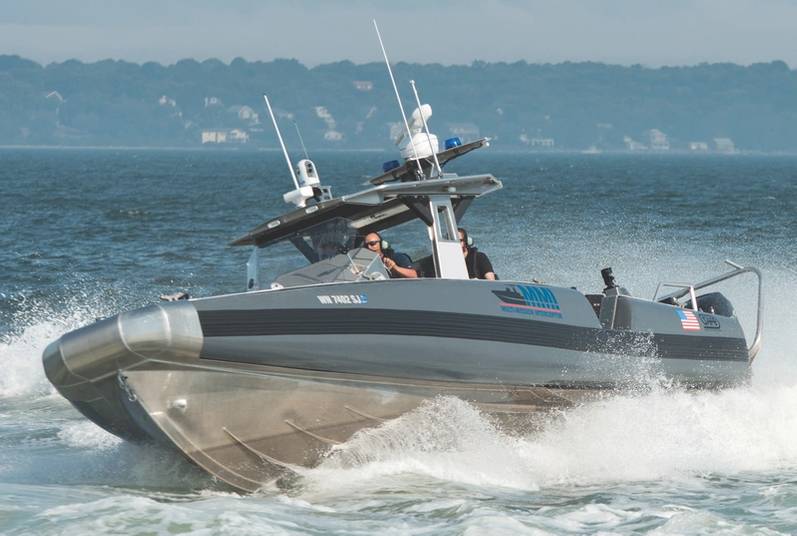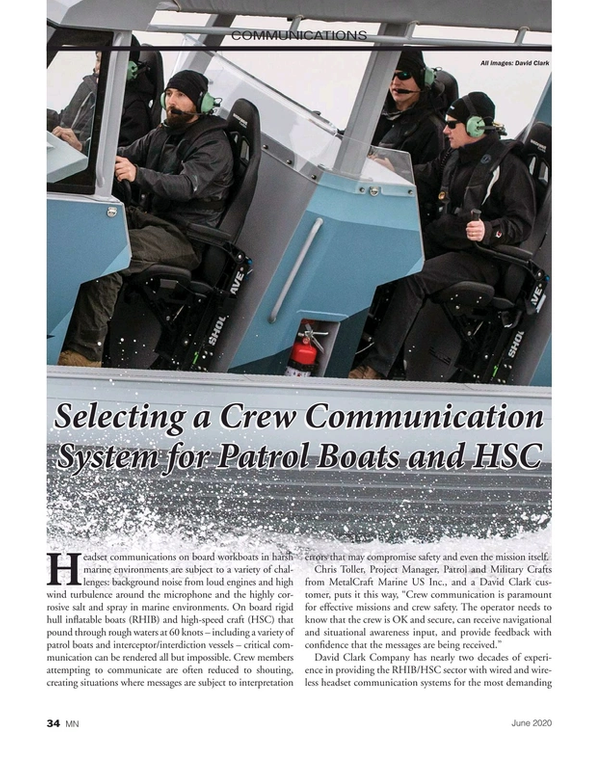
Selecting Crew Comms for High-speed Craft
Headset communications on board workboats in harsh marine environments are subject to a variety of challenges: background noise from loud engines and high wind turbulence around the microphone and the highly corrosive salt and spray in marine environments. On board rigid hull inflatable boats (RHIB) and high-speed craft (HSC) that pound through rough waters at 60 knots – including a variety of patrol boats and interceptor/interdiction vessels – critical communication can be rendered all but impossible. Crew members attempting to communicate are often reduced to shouting, creating situations where messages are subject to interpretation errors that may compromise safety and even the mission itself.
Chris Toller, Project Manager, Patrol and Military Crafts from MetalCraft Marine US Inc., and a David Clark customer, puts it this way, “Crew communication is paramount for effective missions and crew safety. The operator needs to know that the crew is OK and secure, can receive navigational and situational awareness input, and provide feedback with confidence that the messages are being received.”
David Clark Company has nearly two decades of experience in providing the RHIB/HSC sector with wired and wireless headset communication systems for the most demanding marine applications. “With our inhouse state-of-the-art design and engineering resources, we have developed a high level of expertise in producing systems that are built to overcome the obstacles to effective communication at sea,” said Bob Daigle, Systems Product Manager at David Clark Company.
The company has identified three overarching considerations – scalability, versatility and simplicity – that impact the selection, installation, configuration and use of communication systems designed for this demanding market segment. These issues are addressed most effectively by the David Clark Series 9100 Digital Marine Communication System. The system provides clear, headset communication for an unlimited number of users, radios and other devices, with each user being afforded up to four mode selections to program to their unique job criteria.
Scalability for future-proof communication solutions
Scalable digital architecture supports a virtually unlimited number of users. The heart of the 9100 Digital System is the Master Station. All wired and wireless user interfaces and communication headsets are connected through this unit. The Master Station features four card slots for connectivity to Headset Stations, Wireless Gateways, mobile radios, loud hailers and other devices. The Switch Card and Radio/Aux Card Modules enhance system flexibility and scalability to provide an unlimited number of crew members with individualized, streamlined control over a suite of audio and communication devices.
System versatility meets ever-changing mission protocols
The 9100 Digital System provides high performance Ethernet/IP versatility and offers a modular approach to system interface connectivity to two-way radios and other common ancillaries. As the mission profiles of military and first responders on board HSC continually evolve, this architecture provides digital processing of both input and output signals and immense control over communications routing to meet a wider variety of complex command and control requirements.
One of the unique capabilities of the 9100 Digital System that enhance communication versatility and flexibility is the ability to seamlessly integrate wireless headset technology. The integration of wireless technology with the 9100 Digital System provides a hybrid communication solution, combining the reliability and dependability of a wired system with the added freedom and mobility that wireless technology provides. With a myriad of tasks that deck crew must perform on high-speed craft, the ability to communicate with the operator and other crew members untethered and hands-free greatly increases safety, situational awareness and efficiency. Communication via wireless headsets and belt stations is also critical during visit, board, search, seizure (VBSS) operations, allowing crew members to board a suspect craft, while maintaining communication with their vessel.
 (Image: David Clark Company)
(Image: David Clark Company)
System simplicity is critical
System simplicity, encompassing all facets of installation, configuration and operation, is a key factor in the selection of a crew communication system for vessels in the RHIB/HSC sector. System simplicity played an important role in the selection of the 9100 Digital System for installation on the Multi-Mission Interceptor (MMI) demo boat, manufactured by SAFE boats International. “The David Clark [digital communication] system is comfortable, reliable, easy to use and it works...That’s critical for our operators that are out using this equipment,” said Rob Goley, Business Development Director for Federal Programs, SAFE Boats International.
Both hardware and software for the system is built for ease of configuration. Because the system operates on power-over-Ethernet (PoE), all cabling, except for the radio interfacing, is Cat5e. This common communications cabling simplifies installation configuration for boat manufacturers and system installers. Additionally, the system uses a web browser type graphic user interface for programming the system. Configuration of the system can be accomplished by any technician with a laptop and an Ethernet cord. This is especially important for in-field service and system updates.
Operation is simplified with intuitive user interfaces and comfortable, yet durable, noise-attenuating communication headsets. Headset stations and wireless gateways feature a simple control array with pushbutton talk-group selection switches, LED indicators and centrally located PTT switch for fast, effortless access to system functions. Communication headsets feature a PTT switch, conveniently located on the microphone bracket. This intuitively located PTT switch is easy to find and utilize under stressful conditions on board the vessel, while affording simultaneous mic adjustment and transmit capability.
The 9100 Digital System is purpose-built to withstand the harshest marine environments. System components feature marine-grade, water-tight design – including corrosion resistance, wide-ranging temperature tolerance, high performance shock/vibration absorption, and superior dust and water ingress protection – to ensure reliable communications.
David Clark’s 9100 Digital System, in its first few years on the market, has been chosen for hundreds of installations for the U.S. Department of Homeland Security and U.S. Customs and Border Patrol interceptors, as well as on many U.S. Coast Guard small boat programs and international police, SAR and security vessels in the EU, Middle East and Asia Pacific regions.
 (Photo: David Clark Company)
(Photo: David Clark Company)
Read Selecting Crew Comms for High-speed Craft in Pdf, Flash or Html5 edition of June 2020 Marine News
Other stories from June 2020 issue
Content
- Maritime Security: Failing to Prepare is Preparing to Fail page: 14
- The Wing Group: Greater Than the Sum of Its Parts page: 20
- USMI’s Family Recipe page: 28
- Staying Vigilant On and Beneath the Waterline page: 32
- Shipyard Profile: North River Boats page: 32
- Selecting Crew Comms for High-speed Craft page: 34
- Making the Case for Diesel Outboards page: 37
- The Little Bender That Could page: 40
- Keep It Steady page: 45
- i911: Tapping Cellphone Location Data to Save Lives page: 48


